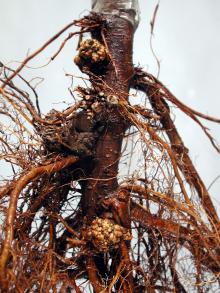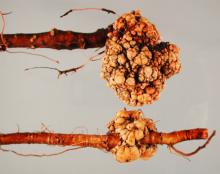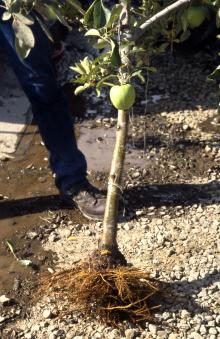See:
Cherry (Prunus spp.) - Crown Gall
Note: In the Pacific Northwest, Malling 7 is considered the most susceptible apple rootstock to Rhizobium rhizogenes (formerly Agrobacterium tumefaciens), followed by Malling 9 and 26.
The Mark rootstock, while susceptible to Rhizobium, has another gall-like problem that resembles crown gall. The cause of this other gall is unknown but appears to be genetically inherited in this particular rootstock.
Chemical control
- Gallex (ready to use) painted on very young galls to reduce further development. Galls may return the next year or, if treated late, may continue to develop. Tissue surrounding the gall may be injured, especially on younger plants. Prepare the surface by removing soil from around the galled area, and allow the area to dry before application. Not registered in Idaho. 24-hr reentry.
Biological control Crown gall on apple has been much more difficult to control than on Prunus species. Agrobacterium radiobacter K84 has been largely ineffective against apple crown gall unless disease pressure is low.
References Sutton, T.B., Aldwinkle, H.S., Agnello, A.M., and Walgenbach, J.F. 2014. Compendium of Apple and Pear Diseases and Pests, 2nd ed. St. Paul, MN: APS Press.
Warner, G. 1993. Once promising Mark rootstock failing many. Good Fruit Grower 44 (15):21-24.




